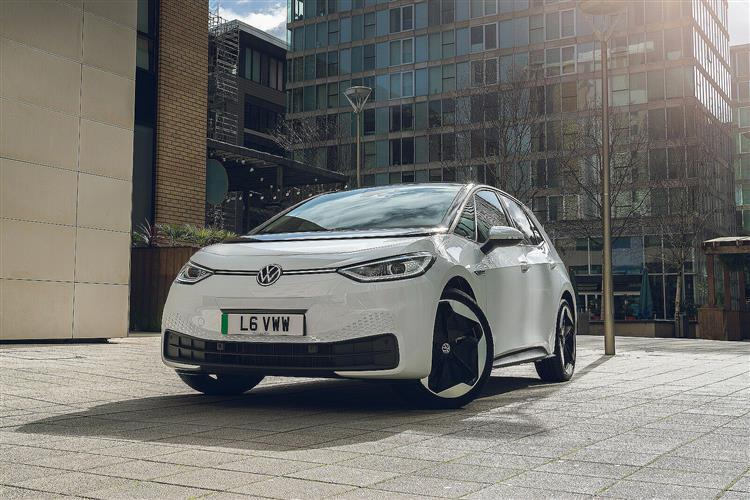How will you view?
This is a sample, and will stop after 30 seconds.
VW'S BIG ID (some text hidden) SECTIONED_new_volkswagenid3_2021
By Jonathan Crouch
Introductionword count: 95
The ID.3 aimed to change the way you think about Volkswagen. And, the brand hoped it would change the way people thought about affordable electric cars. Introduced in 2020, this contender was priced, shaped and designed right for the heart of the family segment of the growing EV sector and, unlike previous battery-powered Volkswagens, it was completely new from the ground up, small enough for the city and big enough for the family. Early ID.3s though had more than a few glitches. Is it worth trying a 2020-2023-era ID.3 on the used market? Let's see.
Modelsword count: 5
5dr hatch (45kWh, 58kWh, 77kWh)
Historyword count: 321
So far, there have been two eras in Volkswagen's history. The first post-war period of the Beetle. And the second modern era, dominated by the company's biggest-selling model, the Golf. The third period started in 2020 with this car, the ID.3, which was the first of many products from the Wolfsburg maker's ID all-electric sub-brand. Prior to the ID.3, we'd had all-electric Volkswagens before of course (the e-Golf and the e-up!) but they'd been based on the underpinnings of ordinary combustion models. The ID range set out to be very different, this ID.3 created around a purpose-designed MEB electrified platform and built at a bespoke EV factory in Zwickau near Dresden. This car was an automotive statement. And also a political one - the Volkswagen Group back in 2020 gradually rehabilitating itself into the eco-part of the global business community after the stigma of the 'dieselgate' scandal. The EV model range this car sired allowed the Wolfsburg conglomerate to commit itself to the goals of the Paris agreement - the 200-nation accord that aimed to limit global warming to 3.6 degrees Fahrenheit by cutting emissions of carbon dioxide and other pollutants. That's why the ID.3 was made using a carbon-neutral production process at a factory which relied entirely on renewable energy. As you can imagine, designing this car wasn't easy. Even a year into production, it wasn't completely finished, persistent software problems having forced Volkswagen to launch the ID.3 in mid-2020 without some of its media features, these latterly restored to early owners with a subsequent software update. But then, era-defining designs are always challenging to create. Is that what this model is? Is it really the electric Peoples' Car, a true Beetle and Golf descendent? And does an early ID.3 make sense as a used buy? Let's see. Here, we'll focus on the early 2020-2023 versions of this model, the cars produced before the mid-term facelift that arrived in mid-2023.
What You Getword count: 659
So, what kind of design is it? Let's take a look. A one-box shape built around its passengers, with uncommonly short overhangs and the axles moved well apart to create a wheelbase almost as long as a Passat. There's a strong C-pillar, a classic Volkswagen design feature, which on the driver's side houses the charging flap. And a softly modelled side section that curves under the rising shoulder line of quite a sporty silhouette featuring a low glasshouse emphasised by dark finishing for the roof, the window frames and the B-pillar. But what's really important is what you can't see. All the key drive stuff sits over the rear axle - principally the single-speed gearbox and the permanent-magnet synchronous electric motor that's been mated to it, which is powered by a high voltage battery that's been efficiently arranged in the underbody to save space. Which leaves nothing to sit at the front end but a few auxiliary units like the air conditioning compressor and of course the steering rack. So, just as with the original rear-engined Beetle, there's no need for a grille. Whatever the colour chosen, dark shades dominate at the rear, the black finish of the large roof spoiler extending down into a central tailgate panel with the brand and model badging. Inside, there are plenty of things you'll need to adjust to. As you enter, a wide, narrow light strip below the windscreen, the 'I.D Light', will indicate the car's readiness to drive. You sit quite high, on top of all those batteries, and the interior design has a minimalist, open plan but rather clinical feel which Volkswagen tried unsuccessfully to lift by imprinting 'Play' and 'Pause' symbols on the two footwell pedals. There's not much in the way of switchgear and of course, you do without conventional instruments, all of this replaced by a couple of TFT displays, a little 5.3-inch one behind the steering wheel and a main tablet of 10-inches in size in the centre of the dash. It all feels a generation on from the cabin design you'd find in rivals from this period like Nissan's LEAF and Kia's e-Niro. Build quality is good but cheaper plastics betray the cost cutting that was necessary to keep this sophisticated EV's asking price within the realms of affordability. Just as in a rival BMW i3 from this time, the gear selector is housed in a right hand protrusion from the instrument binnacle, though here, there's the additional novelty in the fact that the whole binnacle moves up and down as you adjust the wheel. Other adjustments are done using either touch-sensitive buttons (like the fiddly sliders for the climate system); or with voice control prefaced by the command “Hello I.D”. In the back, there's a lot more space than the compact outward dimensions might suggest. It's a wider cabin than that of a Golf or a LEAF and with no central transmission tunnel to obstruct things, three adults could fit more easily into the back of this car than just about any compact hatch from this period we can think of. So yes, the ID.3's a full five-seater, provided the adults in question don't have particularly long legs; there's not a lot of knee room going spare. A LEAF offers a little more space to stretch out but has a lower ceiling and less elbow space too. The boot, at 385-litres, is about the same size as that of a Golf, despite the presence of an electric motor down under the floor. The trunk space on offer is, though, 50-litres less than you'd get in a Nissan LEAF. All those Passat references had led us to expect a little more, but a child buggy or a couple of reasonably sized suitcases should easily fit. If the original owner specified the optional adjustable-height boot floor, you'll get a completely flat cargo area when you flatten the 60:40-split rear bench, which frees up 1,267-litres of capacity.
To see the full road test text contact us on 0330 0020 227
Pictures (high res disabled)

.jpg)
|
.jpg)
|
.jpg)
| |||
.jpg)
|
.jpg)
|
.jpg)
| |||
.jpg)
|
.jpg)
|
.jpg)
| |||
.jpg)
|

|
Scoring (subset of scores)
Category: Hybrid, Plug-in, Electric & Hydrogen
| Performance | |
| Handling | |
| Comfort | |
| Space | |
| Styling, Build, Value, Equipment, Depreciation, Handling, Insurance and Total scores are available with our full data feed. | |



